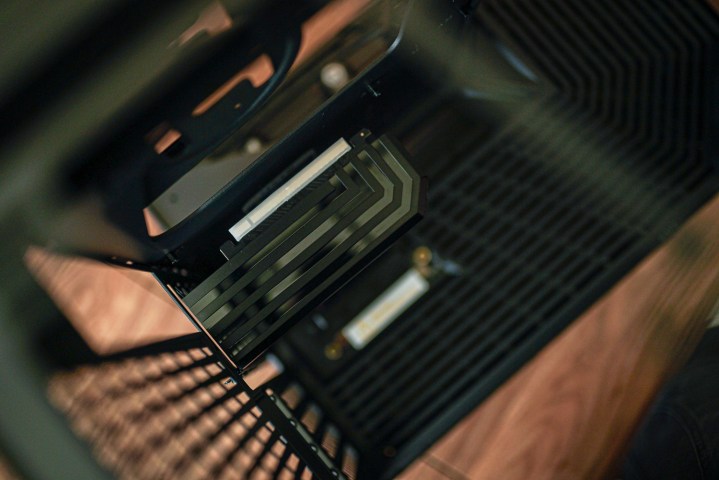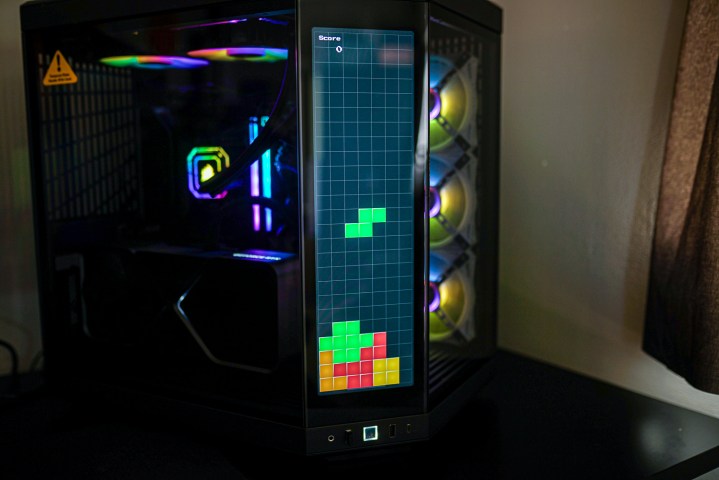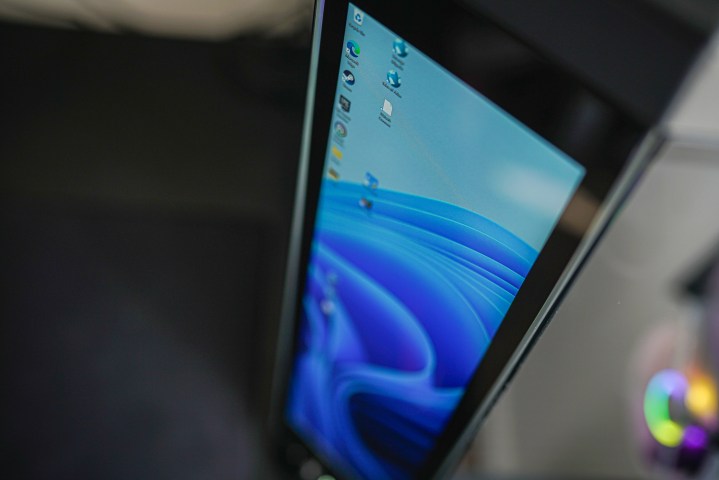
Hyte is challenging the status quo once again. The company, which quickly made it to the top of the list of best PC cases with its Y60, has a crazy new concept called the Y70 Touch. It’s a PC case that has a built-in touchscreen, and although it’s clearly a premium chassis choice, it’s much more attainable than you might expect.
At $360, the Hyte Y70 Touch isn’t just a premium case built exclusively for show floors. It’s a real product, and although it’s much more expensive than most PC cases, it’s not out of the question for a high-end build.
The 10-point multi-touch screen is the main draw of Hyte’s new case, but the company used the opportunity to rethink the design of its wildly popular Y60 and make it an even better option to build your next PC in.
Not your normal Y60

Hyte’s Y60 quickly reached mythical status among the enthusiast PC crowd, sitting alongside cases like the Lian Li PC-O11D. You’d be forgiven for thinking the Y70 Touch is a Y60 with a screen, but it actually has a little more going on.
It carries the same “fish tank” design that has made the Y60 so iconic, but Hyte took some of the lessons it learned with the Hyte Y40 and applied them here. For starters, you don’t have any thumbscrews for the side panels. It’s a completely tool-less design with the Y70 Touch, while the Y60 still uses a thumbscrew for each of the side panels.
Hyte made the case bigger overall, too. The Y60 has a volume of 60 liters, while the Y70 touch is just over 70 liters. It’s a few millimeters taller and longer, and it’s about about 35 millimeters wider. That extra width allows Hyte to squeeze in a fourth PCIe bracket for the vertical GPU mount. That was one of the issues with the Y60 in the wake of graphics cards like the RTX 4090, where some designs can occupy a full four slots.

But one of the biggest improvements comes in the form of fan support. You can now fit three 120mm fans on the bottom or the side of the case. The original Y60 only supports two in either position, leaving an awkward gap at the top and bottom of the fan stack. On the side, you can now fit a 360mm radiator as well, which is a huge boost for this design.
Even better, you can fit a much thicker radiator at the top. The Y70 Touch supports up to a 360mm radiator that’s 68mm thick, while the Y60 was restricted to a 32mm radiator. Hyte removed the dip for the radiator mount that’s present on the Y60, giving you room for a bigger radiator. Hyte also reduced the bezel side on the side panel, giving you a clearer view of your fans.
That’s a lot of changes, but what makes the Y70 Touch so impressive is that you would think it’s the exact same case as the Y60 when looking at it. Despite being bigger, it doesn’t feel any bigger, and you only really notice the difference if you have both cases sitting side by side. I’m glad that Hyte took the opportunity to make its iconic case design better, instead of just slapping an existing screen mod on the same body. The biggest weakness of the Y70 is that Hyte currently isn’t offering it without the touchscreen. But there are some clear improvements here, touchscreen or not.
Let’s talk about the touchscreen

Despite some clear improvements in case design, the showstopper here is the capacitive touchscreen. We need some context, though. Hyte currently sells an LCD mod kit for the Y60 that replaces the corner glass with a screen. It’s $150, bringing the price of a Y60 and a touchscreen mode to $10 less than the Y70 Touch. However, the Y70’s screen is much better.
For starters, the Y70 includes a touchscreen that support up to 10 points of contact. The touchscreen is shockingly useful. You can do things like scroll Twitch chat through Hyte’s Nexus software (more on that soon), as well as pull up and use a calculator widget. Hyte even includes a basic form of Tetris that you can play on the touchscreen.
It’s also a much higher resolution. The Y70 Touch’s display has a resolution of 1,100 x 3,840, which comes out to 283 pixels per inch. That’s extremely sharp for a display. It makes the display feel usable and much less like a gimmick compared to the 515 x 1,920 LCD panel that you can mod the Y60 with.

Hooking it up is much simpler than modding the Y60, too. Hyte hooks up almost everything you need out of the box, so all you’re left to do is run a USB header to your motherboard, connect the DisplayPort cable on the back of the case to your graphics card, and connect SATA power. Hyte includes a small DisplayPort cable with the case, reducing the mess at the back of the case.
Getting everything set up after that point is a little tricky, though. The Y70 Touch includes a screen, and Windows will pick it up as such. There’s no saying if Windows will designate it as your primary display. In my case, Windows picked it up as the primary display, sending me down a short sprint of turning my head sideways and wrestling with the cursor to get everything set up properly.

You can use the Y70 Touch like this, with the screen basically serving as a second monitor. It comes alive with Hyte’s Nexus software, though, enabling widgets and the touchscreen functionality.
Into the Nexus

You need Hyte’s Nexus software to get the Y70 Touch up and running properly. I tested a beta version of the software, but it already shows a ton of promise. Once it’s installed, Nexus runs you through a few simple configuration steps. You need to set up a handful of things in Windows for the display to work properly, and thanks to Nexus, the display was working in less than 30 seconds.
Hyte provides a default configuration, but you have a ton of options to customize the display. Like a smartphone, you have widgets that you can add to the screen, including the calculator widget I mentioned previously. There are a ton of other options, too.
Some highlights include Twitch chat and OBS status, bypassing the need for streamers to have a second monitor. You also have some basic widgets like a clock and weather, along with a media player, performance overlay, and a photo gallery. In addition, Hyte promises Nexus will get widgets for Google Calendar, RSS feeds, notes, an audio visualizer, and IFTTT integration, but they weren’t available the beta version I tested.

In addition, Hyte provides a smartphone-style app row at the bottom, giving you quick access to the Windows File Explorer, Task Manager, and the Tetris-style mini-game. You also have multiple windows you can swipe through, similar to a phone, giving you access to even more widgets.
This is brought together with video backgrounds. Hyte includes several looping backgrounds that you can use, but you can also add your own media to play behind the widgets. Hyte warns this could impact performance, so you thankfully have the option to turn off the videos, go with a gradient background, or set the background as a custom image.
More than a touchscreen

The touchscreen on the Hyte Y70 Touch is definitely a big deal, but you shouldn’t ignore the case itself. This is a premium PC case with smart improvements over an already stellar design, and the touchscreen is just an interesting perk stacked on top.
Still, most people aren’t in the market for a case this expensive. But he Y70 Touch is worth the price, particularly for those looking for a high-end case to keep pace with a high-end PC inside. Anyone not building a top-end PC will have a hard time justifying it, however.
Hopefully Hyte will release a version without the touchscreen in the future. The Y70 is a massively improved version of the Y60, and it would be a go-to recommendation at a reasonable price without the touchscreen.
Editors' Recommendations
- How Hyte is tying your gaming PC together with a single cable
- These recent PC cases make me excited for what’s next
- I fell in love with this PC case that looks like a cheese grater
- Alan Wake 2 is proof that more PC games need a potato mode
- This dual-PC desktop is insane in more ways than one





